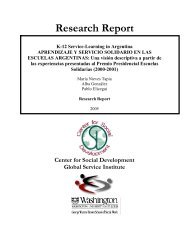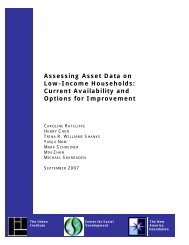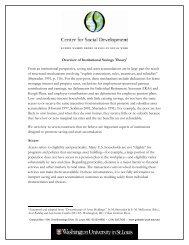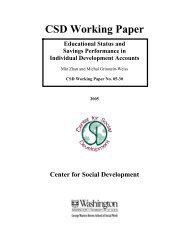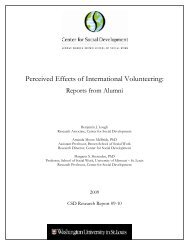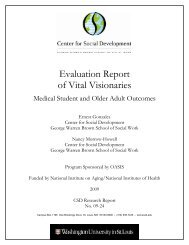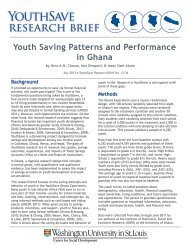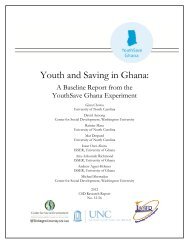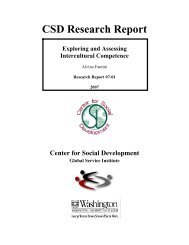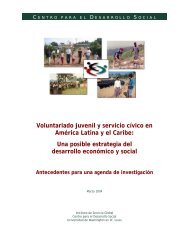Rediscovering social investment in developmental welfare state ...
Rediscovering social investment in developmental welfare state ...
Rediscovering social investment in developmental welfare state ...
Create successful ePaper yourself
Turn your PDF publications into a flip-book with our unique Google optimized e-Paper software.
R E D I S C O V E R I N G S O C I A L I N V E S T M E N T I N D E V E L O P M E N T A L W E L F A R E S T A T E P O L I C I E S :<br />
B A C K T O T H E F U T U R E<br />
language or lexicon that prevails <strong>in</strong> the <strong>welfare</strong> <strong>state</strong> literature. 6 What follows is an abbreviated<br />
<strong>in</strong>tellectual chronology that beg<strong>in</strong>s with the desire to expla<strong>in</strong> the bumblebee anomaly, attempts to<br />
account for our failure to do so, and explicates the need for a new perspective.<br />
Conventional economic logic suggests that there is a tradeoff between efficiency and equality (Okun,<br />
1975). Consistent with this perspective, some countries achieve high efficiency along with high<br />
poverty, while others atta<strong>in</strong> low poverty at high economic cost. Yet some countries do not fit this<br />
pattern and are able to achieve very low levels of poverty with relatively high levels of economic<br />
efficiency. Why are Northern European countries <strong>in</strong> particular, analogous to the bumble bee that is<br />
able to fly when by conventional economic logic, it should not (Persson, 2000)? 7 Generally, evidence<br />
for the negative impact of <strong>welfare</strong> <strong>state</strong>s on economic performance is mixed and any productive<br />
benefits of <strong>social</strong> policy rema<strong>in</strong> relatively poorly understood (Goul Andersen, 2007). As Korpi<br />
(2005) notes, ―the fact that theoretically predicted negative effects of taxes and <strong>welfare</strong> <strong>state</strong>s are<br />
very difficult to verify <strong>in</strong> areas where they are most likely to turn up and <strong>in</strong> which we also have<br />
empirically useful data should generate discussion on the theoretical foundations of these<br />
hypotheses‖ (p. 207). The problem, as Hagen and Sitter (2006) note, is that ―the empirical evidence<br />
is used to refute the neoliberal recipe of how economic efficiency is (or should be) produced,<br />
without, however, be<strong>in</strong>g able to identify what mechanisms expla<strong>in</strong> better what is observed‖ (p. 3). 8<br />
The case of the bumblebee, <strong>in</strong> which a static object is governed by different stability laws than a<br />
dynamic object, poses a challenge to theoretical oversimplifications that sometimes occur <strong>in</strong><br />
economics (L<strong>in</strong>dert, 2004b). Explanations for anomalous outcomes have yet to be developed.<br />
An <strong>in</strong>tegrative assessment and synthesis of the relevant literature reveals that (1) <strong>welfare</strong> <strong>state</strong>s face a<br />
variety of pressures and dilemmas, (2) there is a long legacy of conceptual ambiguity surround<strong>in</strong>g the<br />
6 Nordic researchers such as Kangas and Palme (2005) have begun to focus on the <strong>developmental</strong> aspect of <strong>social</strong> policy.<br />
In particular, they study how to bridge the divide between development studies and study of the <strong>welfare</strong> <strong>state</strong> and<br />
explore how <strong>social</strong> policy may facilitate economic development. However, these efforts have not explicitly revisited the<br />
<strong>social</strong> development literature or attempted to def<strong>in</strong>e <strong>developmental</strong>ism <strong>in</strong> the context of comparative <strong>welfare</strong> <strong>state</strong><br />
research. Kangas and Palme (2005) is part of the UNRISD series, Social Policy <strong>in</strong> a Development Context, which exam<strong>in</strong>es the<br />
ways that <strong>social</strong> policy can be <strong>in</strong>strumental to economic development while ma<strong>in</strong>ta<strong>in</strong><strong>in</strong>g its goal of <strong>social</strong> protection and<br />
equity. In a recent report by the Institute for Futures Studies (Morel, Palier, & Palme, 2009), the <strong>social</strong> <strong><strong>in</strong>vestment</strong><br />
paradigm is identified as the def<strong>in</strong><strong>in</strong>g feature of the new <strong>welfare</strong> <strong>state</strong> and it suggests the need for new strategies for<br />
achiev<strong>in</strong>g equality with growth. In contrast, <strong>developmental</strong>ism—as I redef<strong>in</strong>e it here—is concerned with the types of<br />
policies that Myrdal historically saw as <strong><strong>in</strong>vestment</strong>s <strong>in</strong> the population and as a complement to the <strong>social</strong> rights<br />
perspective (L<strong>in</strong>dh, 2009).<br />
7 In remarks before the Social Democratic Extra Party Congress <strong>in</strong> Stockholm, 10–12 March 2000, liken<strong>in</strong>g the Swedish<br />
<strong>welfare</strong> <strong>state</strong> to a bumblebee, former Swedish Prime M<strong>in</strong>ister Göran Persson, suggested that ―with his altogether too<br />
heavy body and th<strong>in</strong> w<strong>in</strong>gs he should not be able to fly,‖ but he noted that ―all the same he does.‖ Accord<strong>in</strong>g to 20th<br />
century folklore, the laws of aerodynamics prove that the bumble bee should be <strong>in</strong>capable of flight, as it does not have<br />
the capacity (<strong>in</strong> terms of w<strong>in</strong>g size or beat per second) to achieve flight with the degree of w<strong>in</strong>g load<strong>in</strong>g necessary, and<br />
yet, not be<strong>in</strong>g aware of scientists prov<strong>in</strong>g it cannot fly, the bumblebee succeeds. John McMasters (1989) recounted an<br />
anecdote about an unnamed Swiss aerodynamicist at a d<strong>in</strong>ner party who performed some rough calculations and<br />
concluded, presumably <strong>in</strong> jest, that accord<strong>in</strong>g to the equations, bumblebees cannot fly. In later years, McMasters backed<br />
away from this orig<strong>in</strong>, suggest<strong>in</strong>g that there could be multiple sources, and that the earliest he has found was a reference<br />
<strong>in</strong> the 1934 French book Le vol des <strong>in</strong>sectes by M. Magnan. Magnan is reported to have written that he and a M. Sa<strong>in</strong>t-<br />
Lague had applied the equations of air resistance to <strong>in</strong>sects and found that their flight was impossible, but that ―One<br />
shouldn‘t be surprised that the results of the calculations don‘t square with reality.‖ It is believed that the calculations<br />
that purported to show that bumblebees cannot fly are based upon a simplified l<strong>in</strong>ear treatment of oscillat<strong>in</strong>g aerofoils.<br />
The method underestimates the additional lift generated by the bumblebee‘s w<strong>in</strong>gs that allow it to fly.<br />
8 See Johnson (2010) for a more extensive discussion of the mixed economic evidence.<br />
C E N T E R F O R S O C I A L D E V E L O P M E N T<br />
W A S H I N G T O N U N I V E R S I T Y I N S T . L O U I S<br />
6



